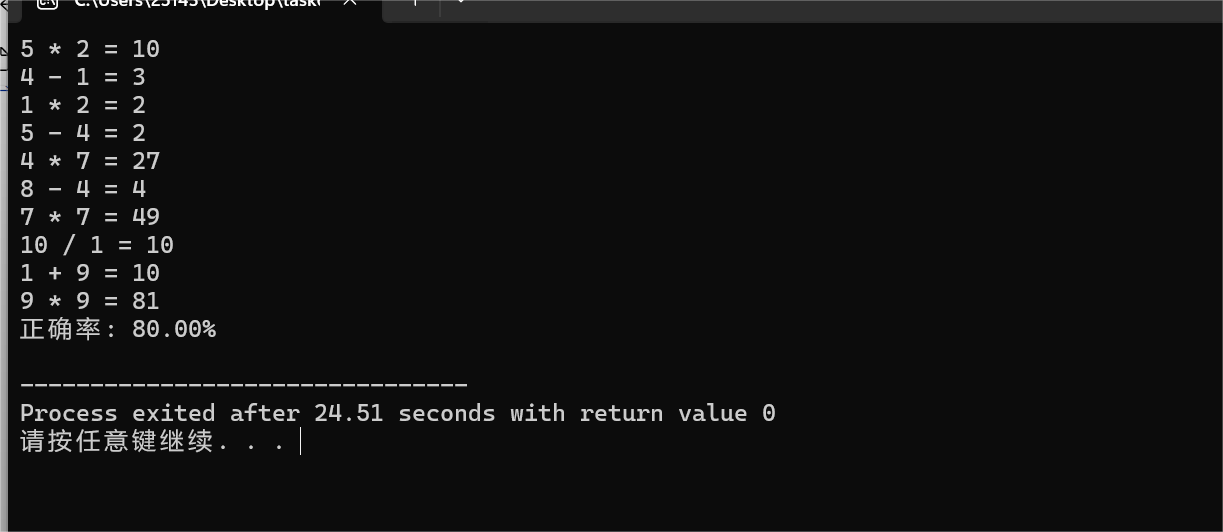实验1
任务1:
task1.cpp
// 现代C++标准库、算法库体验 // 本例用到以下内容: // 1. 字符串string, 动态数组容器类vector、迭代器 // 2. 算法库:反转元素次序、旋转元素 // 3. 函数模板、const引用作为形参 #include <iostream> #include <string> #include <vector> #include <algorithm> using namespace std; // 声明 // 模板函数声明 template<typename T> void output(const T &c); // 普通函数声明 void test1(); void test2(); void test3(); int main() { cout << "测试1: \n"; test1(); cout << "\n测试2: \n"; test2(); cout << "\n测试3: \n"; test3(); } // 函数实现 // 输出容器对象c中的元素 template <typename T> void output(const T &c) { for(auto &i: c) cout << i << " "; cout << endl; } // 测试1 // 组合使用算法库、迭代器、string反转字符串 void test1() { string s0{"0123456789"}; cout << "s0 = " << s0 << endl; string s1{s0}; reverse(s1.begin(), s1.end()); // 反转指定迭代器区间的元素 cout << "s1 = " << s1 << endl; string s2{s0}; reverse_copy(s0.begin(), s0.end(), s2.begin()); // 将指定迭代区间的元素拷贝 到指定迭代器开始的目标区间,并且在复制过程中反转次序 cout << "s2 = " << s2 << endl; } // 测试2 // 组合使用算法库、迭代器、vector反转动态数组对象vector内数据 void test2() { vector<int> v0{2, 0, 4, 9}; cout << "v0: "; output(v0); vector<int> v1{v0}; reverse(v1.begin(), v1.end()); cout << "v1: "; output(v1); vector<int> v2{v0}; reverse_copy(v0.begin(), v0.end(), v2.begin()); cout << "v2: "; output(v2); } // 测试3 // 组合使用算法库、迭代器、vector实现元素旋转移位 void test3() { vector<int> v0{0, 1, 2, 3, 4, 5, 6, 7, 8, 9}; cout << "v0: "; output(v0); vector<int> v1{v0}; rotate(v1.begin(), v1.begin()+1, v1.end()); // 旋转指定迭代器区间 [v1.begin(), v1.end())之间的数据项,旋转后从迭代器v1.begin()+1位置的数据项开始 cout << "v1: "; output(v1); vector<int> v2{v0}; rotate(v2.begin(), v2.begin()+2, v2.end()); cout << "v2: "; output(v2); vector<int> v3{v0}; rotate(v3.begin(), v3.end()-1, v3.end()); cout << "v3: "; output(v3); vector<int> v4{v0}; rotate(v4.begin(), v4.end()-2, v4.end()); cout << "v4: "; output(v4); }
运行结果截图: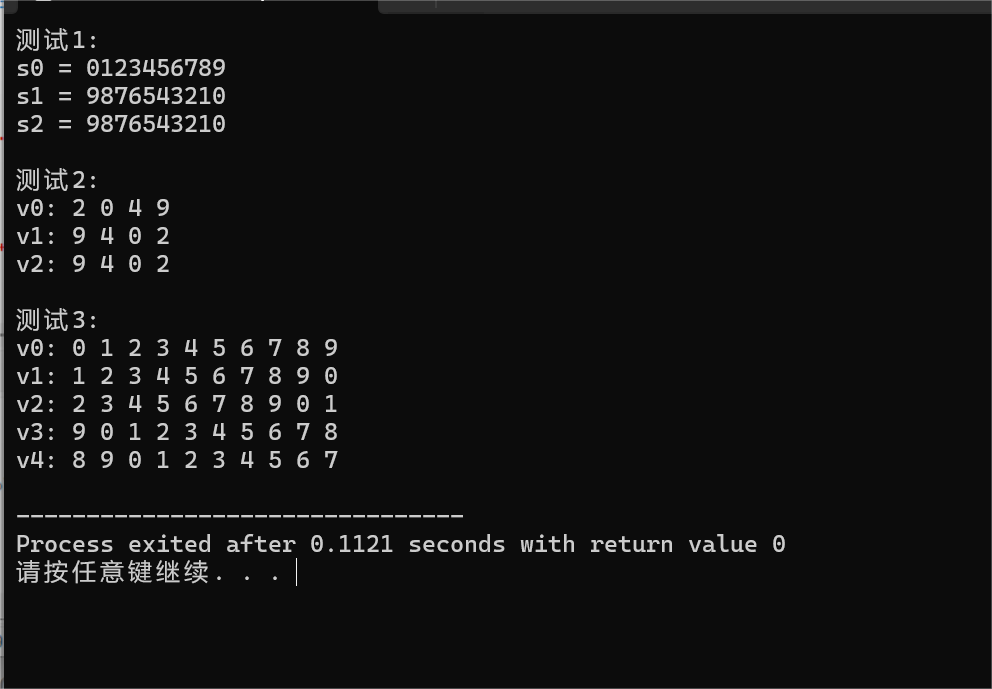
任务2:
task2.cpp
#include <iostream> #include <vector> #include <string> #include <algorithm> #include <numeric> #include <iomanip> using namespace std; // 函数声明 // 模板函数声明 template<typename T> void output(const T &c); // 普通函数声明 int rand_int_100(); void test1(); void test2(); int main() { cout << "测试1: \n"; test1(); cout << "\n测试2: \n"; test2(); } // 函数实现 // 输出容器对象c中的元素 template <typename T> void output(const T &c) { for(auto &i: c) cout << i << " "; cout << endl; } // 返回[0, 100]区间内的一个随机整数 int rand_int_100() { return rand() % 101; } // 测试1 // 对容器类对象指定迭代器区间进行赋值、排序 void test1() { vector<int> v0(10); // 创建一个动态数组对象v0, 对象大小为10 generate(v0.begin(), v0.end(), rand_int_100); // 产生[0, 100]之间的随机整数 赋值给指定迭代器区间[v0.begin(), v0.end())内的每个数据项 cout << "v0: "; output(v0); vector<int> v1{v0}; sort(v1.begin(), v1.end()); // 对指定迭代器区间[v1.begin(), v1.end())内数据 项进行升序排序 cout << "v1: "; output(v1); vector<int> v2{v0}; sort(v2.begin()+1, v2.end()-1); // 对指定迭代器区间[v1.begin()+1, v1.end()-1)内数据项进行升序排序 cout << "v2: "; output(v2); } // 测试2 // 对容器类对象指定迭代器区间进行赋值、计算最大值/最小值/均值 void test2() { vector<int> v0(10); generate(v0.begin(), v0.end(), rand_int_100); cout << "v0: "; output(v0); auto iter1 = min_element(v0.begin(), v0.end()); cout << "最小值: " << *iter1 << endl; auto iter2 = max_element(v0.begin(), v0.end()); cout << "最大值: " << *iter2 << endl; auto ans = minmax_element(v0.begin(), v0.end()); cout << "最小值: " << *(ans.first) << endl; cout << "最大值: " << *(ans.second) << endl; double avg1 = accumulate(v0.begin(), v0.end(), 0)/v0.size(); cout << "均值: " << fixed << setprecision(2) << avg1 << endl; cout << endl; vector<int> v1{v0}; cout << "v0: "; output(v0); sort(v1.begin(), v1.end()); double avg2 = accumulate(v1.begin()+1, v1.end()-1, 0)/(v1.size()-2); cout << "去掉最大值、最小值之后,均值: " << avg2 << endl; }
运行结果截图:
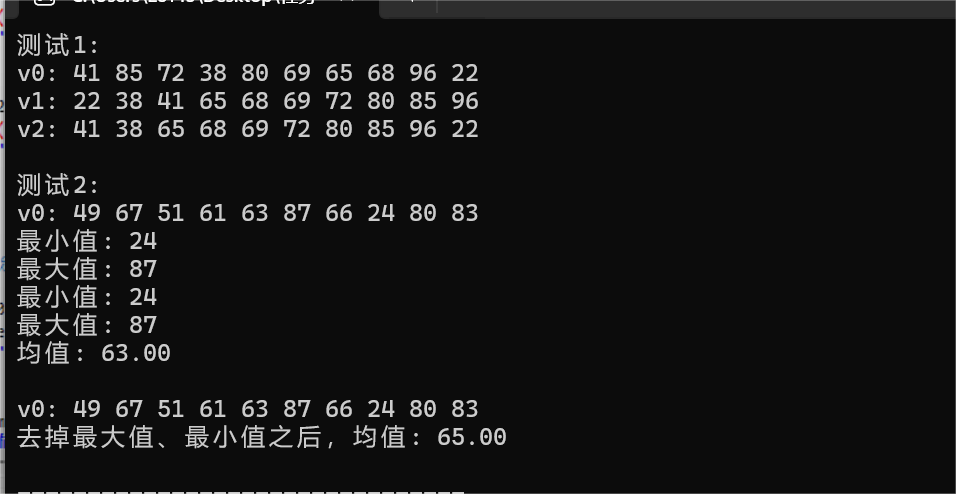
任务3:
task3.cpp
#include <iostream> #include <string> #include <algorithm> bool is_palindrome(std::string s); int main() { using namespace std; string s; while(cin >> s) // 多组输入,直到按下Ctrl+Z后结束测试 cout << boolalpha << is_palindrome(s) << endl; } // 函数is_palindrom定义 bool is_palindrome(std::string s){ using namespace std; bool a=false,b=true; string str = s; int len = s.size(); char temp; for(int i=0; i<len/2; i++){ temp = s[i]; s[i]=s[len-i-1]; s[len-i-1]=temp; } if(str==s) return true; else return false; }
运行结果截图
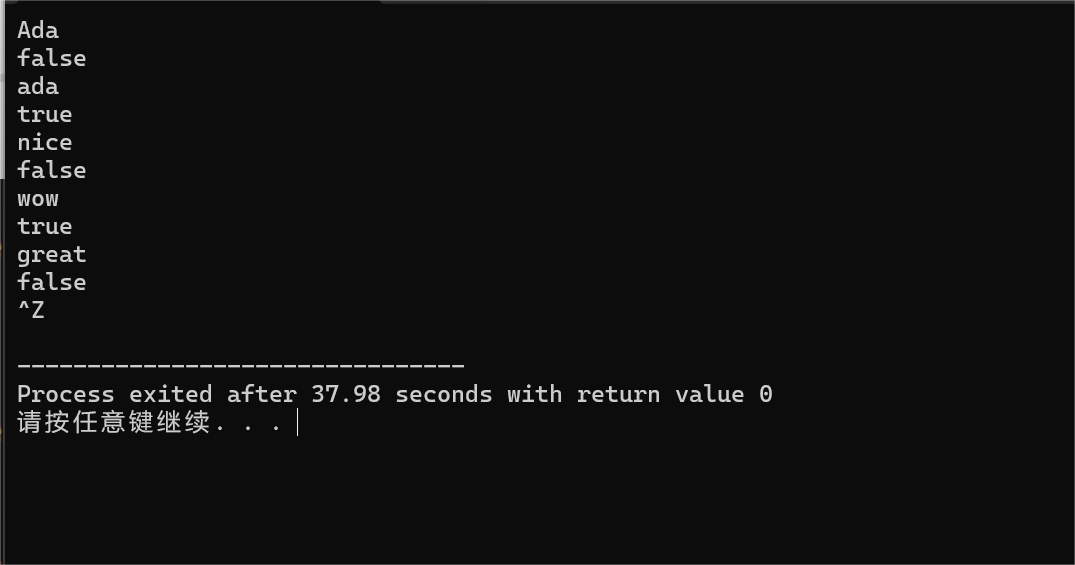
任务4
task4.cpp
#include <iostream> #include <string> #include <algorithm> std::string dec2n(int x, int n = 2); int main() { using namespace std; int x; while(cin >> x) { cout << "十进制: " << x << endl; cout << "二进制: " << dec2n(x) << endl; cout << "八进制: " << dec2n(x, 8) << endl; cout << "十六进制: " << dec2n(x, 16) << endl << endl; } } // 函数dec2n定义 std::string dec2n(int x, int n) { if (x == 0) return "0"; const char digits[] = "0123456789ABCDEFGHIJKLMNOPQRSTUVWXYZ"; std::string result; while (x > 0) { result += digits[x % n]; x /= n; } std::reverse(result.begin(), result.end()); return result; }
运行结果截图
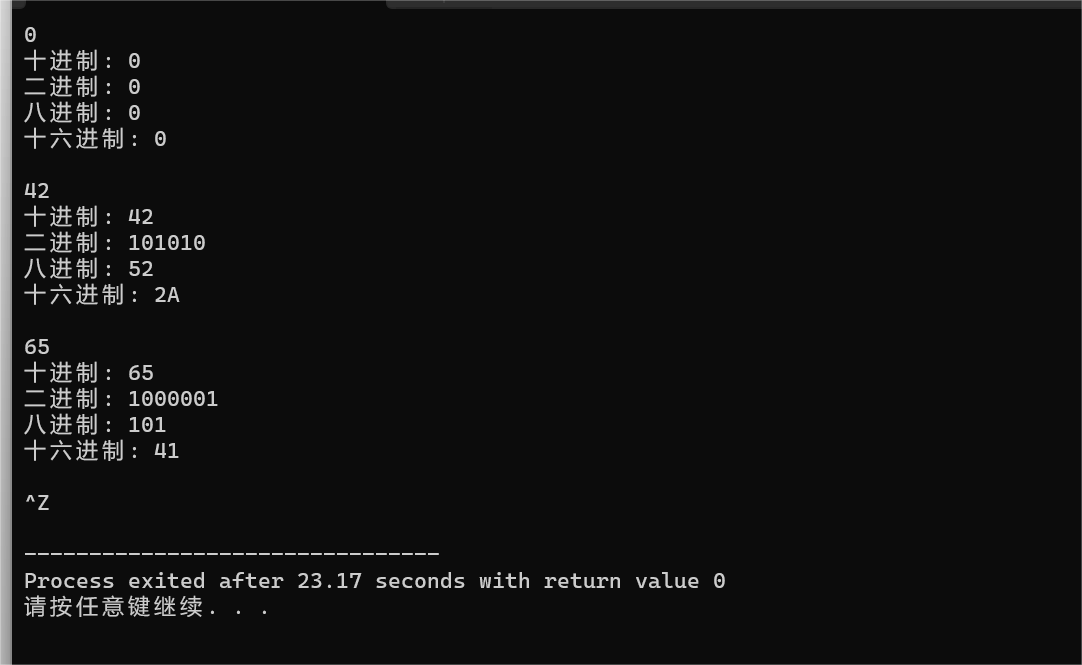
任务5:
task5.cpp
#include<iostream> #include<iomanip> using namespace std; int main() { int count=1; int i,j; cout<<" "; for(i=97;i<97+26;i++) { cout<<setw(2)<<char(i); } cout<<endl; for(i=1;i<=26;i++) { cout<<setw(2)<<i; for(j=i+1;j<=26;j++) { cout<<setw(2)<<char(j+64); } for(j=1;j<=i;j++) { cout<<setw(2)<<char(j+64); } cout<<endl; } return 0; }
运行结果截图

任务6:
task6.cpp
#include <iostream> #include <cstdlib> #include <ctime> #include <iomanip> using namespace std; int randomInRange(int min, int max) { return rand() % (max - min + 1) + min; } pair<int, int> generateDivisiblePair() { int divisor = randomInRange(1, 10); int dividend = divisor * randomInRange(1, 10); return {dividend, divisor}; } pair<int, int> generateSubtractPair() { int minuend = randomInRange(2, 10); int subtrahend = randomInRange(1, minuend - 1); return {minuend, subtrahend}; } double generateAndEvaluateQuestions() { srand(static_cast<unsigned>(time(0))); int correctAnswers = 0; for (int i = 0; i < 10; ++i) { int operation = randomInRange(0, 3); pair<int, int> operands; switch (operation) { case 0: operands = {randomInRange(1, 10), randomInRange(1, 10)}; cout << operands.first << " + " << operands.second << " = "; break; case 1: operands = generateSubtractPair(); cout << operands.first << " - " << operands.second << " = "; break; case 2: operands = {randomInRange(1, 10), randomInRange(1, 10)}; cout << operands.first << " * " << operands.second << " = "; break; case 3: operands = generateDivisiblePair(); cout << operands.first << " / " << operands.second << " = "; break; } int userAnswer; cin >> userAnswer; int correctAnswer; switch (operation) { case 0: correctAnswer = operands.first + operands.second; break; case 1: correctAnswer = operands.first - operands.second; break; case 2: correctAnswer = operands.first * operands.second; break; case 3: correctAnswer = operands.first / operands.second; break; } if (userAnswer == correctAnswer) { ++correctAnswers; } } double accuracy = static_cast<double>(correctAnswers) / 10 * 100; cout << fixed << setprecision(2) << "正确率: " << accuracy << "%" << endl; return accuracy; } int main() { generateAndEvaluateQuestions(); return 0; }
运行结果截图
